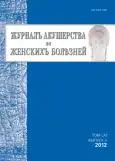CYP21A2 gene mutationsin the women with recurrent miscarriage
- Authors: Osinovskaya N.S.1, Sultanov I.Y.1, Ivaschenko T.E.1, Baranov V.S.2
-
Affiliations:
- Laboratory of prenatal diagnostics of congenial and hereditary diseases
- D. O. Ott Research Institute of Obstetrics and Gynecology NWB RAMS
- Issue: Vol 61, No 3 (2012)
- Pages: 104-108
- Section: Articles
- URL: https://journals.rcsi.science/jowd/article/view/1293
- DOI: https://doi.org/10.17816/JOWD613104-108
- ID: 1293
Cite item
Full Text
Abstract
Keywords
Full Text
##article.viewOnOriginalSite##About the authors
Natalya Sergeevna Osinovskaya
Laboratory of prenatal diagnostics of congenial and hereditary diseases
Email: natosinovskaya@mail.ru
PhD, senior research fellow
Iskender Yuryevich Sultanov
Laboratory of prenatal diagnostics of congenial and hereditary diseasesassistant
Tatyana Eduardovna Ivaschenko
Laboratory of prenatal diagnostics of congenial and hereditary diseasesDr. Sci, Prof., Leading Researcher
Vladislav Sergeevich Baranov
D. O. Ott Research Institute of Obstetrics and Gynecology NWB RAMSDr. Sci, Prof., Corresponding Member of RAMN, head of the laboratory of prenatal diagnostics of congenial and hereditary diseases
References
- Качалина Т. С. Гиперандрогения и невынашивание беременности // Российский вестник акушера-гинеколога. — 2004. — № 3. — С. 469–481.
- Кошелева Н. Г. Современная тактика лечения и профилактики невынашивания беременности с учетом этиопатогенеза // Вестник Российской ассоциации акушеров-гинекологов. — 1996. — № 3. — С. 45–51.
- Осиновская Н. С. Особенности проведения молекулярной диагностики при врожденной гиперплазии коры надпочечников // Молекулярно-биологические технологии в медицинской практике. — Новосибирск: Альфа-Виста, 2002. — вып. 2. — С. 111–119.
- Adrenal 21-hydroxylase gene mutations in Slovenian hyperandrogenic women: evaluation of corticotrophin stimulation and HLA polymorphisms in screening for carrier status / Dolzan V. [et al.] // Eur. J. Endocrinol. — 1999. — Vol. 141, № 2. — P. 132–139.
- An unequal crossover event in RCCX modules of the human MHC resulting in the formation of a TNXB/TNXA hybrid and deletion of the CYP21A / Jaatinen T. [et al.] // Hum. Immunol. — 2002. — Vol. 63, № 8. — P. 683–689.
- Characterisation of CAH alleles with non-radioactive DNA single strand conformation polimorphism analysis of the CYP21 gene / Bobba A. [et al.] // J. Med. Genet. — 1997. — Vol. 34. — P. 223–228.
- Direct molecular diagnosis of CYP21 mutations in congenital adrenal hyperplasia / Lee H. [et al.] // J. Med. Genet. — 1996. — Vol. 33. — P. 371–375.
- Endocrinological and endometrial factors in recurrent miscarriage / Li T. C. [et al.] // British J. Obst. and Gynaecol. — 2000. — Vol. 107. — P. 1471–1479.
- Fertility in women with lateonset adrenal hyperplasia due to 21-hydroxylase deficiency / Feldman S. [et al.] // Clin. Endocrinol. Metab. — 1992. — Vol. 74. — P. 635–639.
- Fertility in women with nonclassical congenital adrenal hyperplasia due to 21-hydroxylase deficiency / Bidet M. [et al.] // J. Clin. Endocrinol. Metab. — 2010. — Vol. 95, № 3. — P. 1182–1190.
- Goncalves J., Friaes A., Moura L. Congenital adrenal hyperplasia: focus on the molecular basis of 21-hydroxylase deficiency // Expert reviews in molecular medicine. — 2007. — Vol. 9, № 11. — P. 1–23.
- Hanukoglu I. Steroidogenic enzymes: structure, function, and role in regulation of steroid hormone biosynthesis // J. Steroid Biochem. Molec. Biol. — 1992. — Vol. 43, № 8. — P. 779–804.
- Krone N. Genetics of congenital adrenal hyperplasia // Best Practice Res. Clin. Endocrinol. Metabolism. — 2009. — Vol. 23. — P. 181–192.
- Meka A., Reddy B. M. Recurrent spontaneous abortions: an overview of genetic and non-genetic backgrounds // Int. J. Hum. Genet. — 2006. — Vol. 6, № 2. — P. 109–117.
- New M. I. Nonclassical 21-hydroxylase deficiency // J. Clin. Endocrinol. Metabolism. — 2006. — Vol. 91, № 11. — P. 4205–4214.
- Reproductive outcome of women with 21-hydroxylase-deficient nonclassic adrenal hyperplasia / Moran C. [et al.] // J. Clin. Endocrinol. Metabolism. — 2006. — Vol. 91, № 9. — P. 3451–3456.
- Sambrook J., Fritsch E. F., Maniatis T. Molecular cloning. A laboratory manual // Cold Spring Harbor Laboratory Press. — 2001. — P. 1–245.
- The frequency of CYP 21 gene mutations in Turkish women with hyperandrogenism Kelestimur F. [et al.] // J. Experimental clin. Endocrinol. diabetes. — 2009. — Vol. 117, № 5. — P. 205–208.
- White P. C., Speiser P. W. Congenital adrenal hyperplasia due to 21-hydroxylase deficiency // Endocrine reviews. — 2000. — Vol. 21, № 3. — P. 245–291.
- Witchel S. F., Azziz R. Nonclassic congenital adrenal hyperplasia // International journal of pediatric endocrinology. 2010. URL: http://www. ncbi.nlm.nih.gov/pmc/articles/PMC2910408/pdf/ IJPE2010–625105.pdf. — (дата обращения 01.02.2012).
Supplementary files







